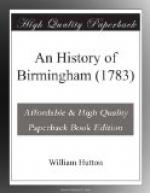The ditch being filled with water, has nearly the same appearance now as perhaps a thousand years ago, but not altogether the same use. It then served to protect its master, but now, to turn a thread-mill.
PUDDING BROOK.
Near the place where the small rivulet discharges itself into the Moat, another of the same size is carried over it, called Pudding Brook, and proceeds from the town as this advances towards it, producing a curiosity seldom met with; one river running South, and the other North, for half a mile, yet only a path-road of three feet asunder; which surprised Brindley the famous engineer.
THE PRIORY.
The site of this ancient edifice is now the Square; some small remains of the old foundations are yet visible in the cellars, chiefly on the South-east. The out-buildings and pleasure-grounds perhaps occupied the whole North east side of Bull-street, then uninhabited, and only the highway to Wolverhampton; bounded on the North-west by Steelhouse-lane; on the North-east by Newton and John’s-street; and on the South-east by Dale-end, which also was no other than the highway to Lichfield—The whole, about fourteen acres.
The building upon this delightful eminence, which at that time commanded the small but beautiful prospect of Bristland-fields, Rowley-hills, Oldbury, Smethewick, Handsworth, Sutton-Coldfield, Erdington, Saltley, the Garrison, and Camp-hill, and which then stood at a distance from the town, though now near its centre; was founded by the house of Birmingham, in the early reigns of the Norman Kings, and called the Hospital of Saint Thomas,—The priest being bound to pray for the souls of the founders every day, to the end of the world.
In 1285, Thomas de Madenhache, Lord of the manor of Aston, gave ten acres of land in his manor. William de Birmingham ten, which I take to be the land where the Priory stood; and Ranulph de Rakeby three acres, in Saltley: About the same time, sundry others gave houses and land in smaller quantities: William de Birmingham gave afterwards twenty-two acres more. The same active spirit seems to have operated in our ancestors, 500 years ago, that does in their descendants at this day: If a new scheme strikes the fancy, it is pursued with vigor.
The religious fervor of that day ran high: It was unfashionable to leave the world, and not remember the Priory. Donations crowded in so fast, that the prohibiting act was forgot; so that in 1311, the brotherhood were prosecuted by the crown, for appropriating lands contrary to the act of mortmain; But these interested priests, like their sagacious brethren, knew as well how to preserve as to gain property; for upon their humble petition to the throne, Edward the Second put a stop to the judicial proceedings, and granted a special pardon.
In 1351, Fouk de Birmingham, and Richard Spencer, jointly gave to the priory one hundred acres of land, part lying in Aston, and part in Birmingham, to maintain another priest, who should celebrate divine service daily at the altar of the Virgin Mary, in the church of the hospital, for the souls of William la Mercer, and his wife. The church is supposed to have stood upon the spot now No. 27, in Bull-street.




